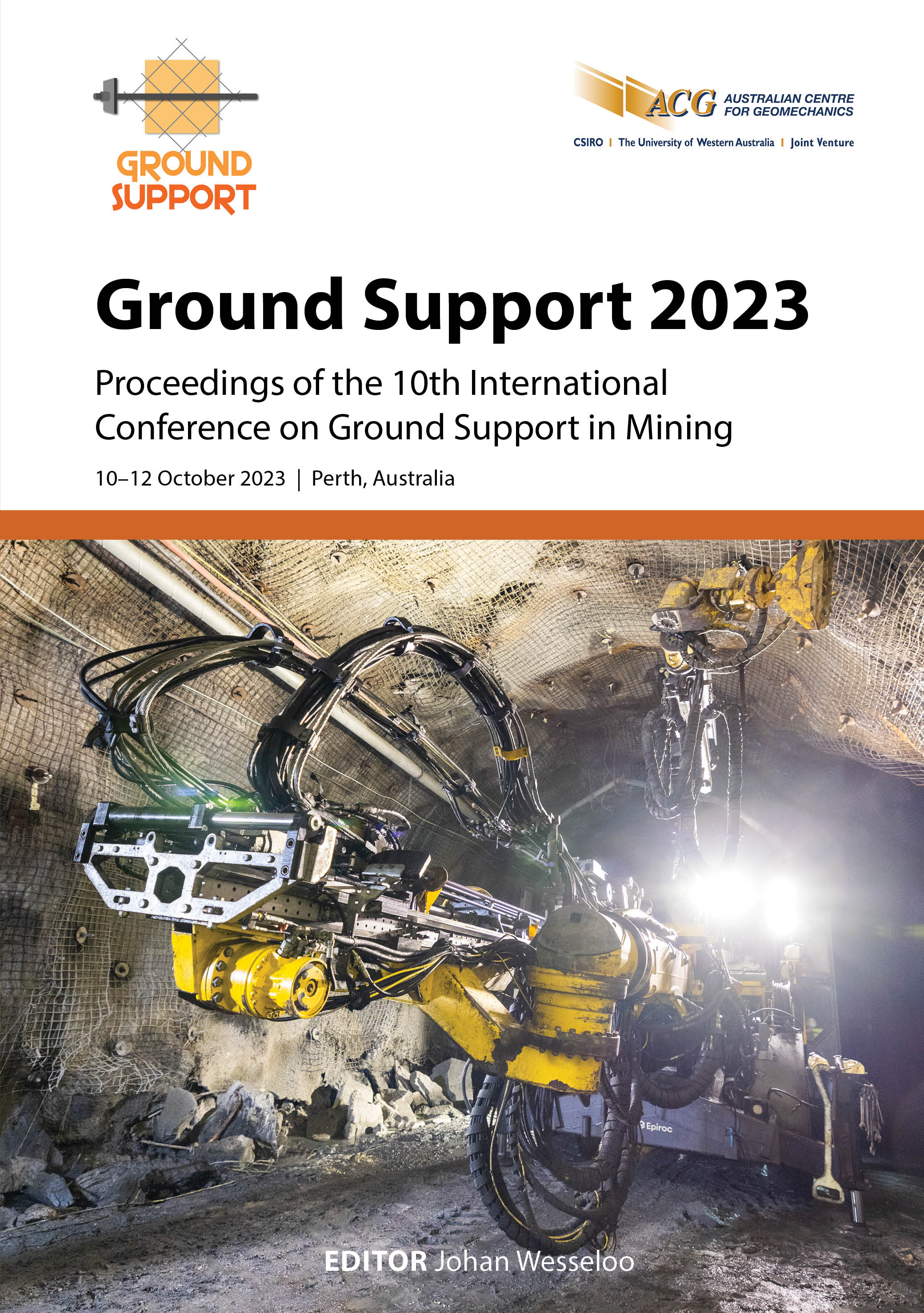Utilisation of seismic data in the assessment of displacement and energy demand imposed on ground support by strainbursts

|
Authors: Malovichko, D |
DOI https://doi.org/10.36487/ACG_repo/2325_12
Cite As:
Malovichko, D 2023, 'Utilisation of seismic data in the assessment of displacement and energy demand imposed on ground support by strainbursts', in J Wesseloo (ed.), Ground Support 2023: Proceedings of the 10th International Conference on Ground Support in Mining, Australian Centre for Geomechanics, Perth, pp. 181-196, https://doi.org/10.36487/ACG_repo/2325_12
Abstract:
Conventional processing of seismic monitoring data recorded in mines often adopts models and methods established in global seismology and focused mainly on tectonic earthquakes. These models and methods make it possible to evaluate geometrical and mechanical characteristics of sources (e.g. orientation and dimensions of the slip surface or shear failure zone, the direction and amount of slip or shear deformation) and the intensity of associated ground motion (typically, peak ground velocity in the vicinity of failure and at a distance from it). Forecasting of ground motion intensity for planned mining is important for the assessment of energy demand on ground support in terms of shakedown damage. Strong ground motion temporarily increases stress around tunnels and may also deepen the depth of failure, which will cause dynamic loading of ground support due to bulking (induced strainbursting damage mechanism). A new seismic source model has been suggested in recent years. It describes seismic radiation from an episode of sudden stress fracturing around a tunnel. The model makes it possible to infer the increment in the depth of failure and duration of this process from recorded seismic signals. Application of this model to relevant seismic events (those locating to tunnels with crush-type mechanisms) can be used to: (a) establish a relation between bulking duration and increment in the depth of failure (depth of strainbursting), (b) evaluate the cumulative depth of strainbursting for tunnels of the mine, (c) assess the amount and probability of strainbursting realisations. The paper discusses these applications and their utilisation for the assessment of displacement and energy demand on ground support.
Keywords: crush-type seismic source mechanism, depth of strainbursting, bulking duration
References:
Baker, JW 2015, ‘Efficient analytical fragility function fitting using dynamic structural analysis’, Earthquake Spectra, vol. 31, no. 1, pp. 579–599.
Bird, JF & Bommer, JJ 2004, ‘Earthquake losses due to ground failure’, Engineering Geology, vol. 75, pp. 147–179.
Boatwright, J 1980, ‘A spectral theory for circular seismic sources; simple estimates of source dimension, dynamic stress drop, and radiated seismic energy, Bulletin of the Seismological Society of America, vol. 70, no. 1, pp. 1–27.
Brune, JN 1970, ‘Tectonic stress and the spectra of seismic shear waves from earthquakes’, Journal of Geophysical Research, vol. 75, no. 26, pp. 4997–5009.
Brune, JN, Archuleta, RJ & Hartzell, S 1979, ‘Far-field S-spectra, corner frequencies, and pulse shapes’, Journal of Geophysical Research, vol. 84, no. B5, pp. 2262–2272.
Cuello, D, Mendecki, A & Mountfort, PJ 2017, ‘Ground motion amplification at the skin of excavations’, in JA Vallejos (ed.), Proceedings of the 9th International Symposium on Rockbursts and Seismicity in Mines, Society for Mining, Metallurgy & Exploration, Engelwood, pp. 216–220.
Dziewonski, AM & Woodhouse, JH 1983, ‘An experiment in systematic study of global seismicity: Centroid-moment tensor solutions for 201 moderate and large earthquakes of 1981’, Journal of Geophysical Research, vol. 88, no. B4, pp. 3247–3271.
Hasegawa, H, Wetmiller, R & Gendzwill, D 1989, ‘Induced seismicity in mines in Canada—an overview’, Pure and Applied Geophysics, vol. 129, no. 3/4, pp. 423–453.
Julia, J, Nyblade, AA, Durrheim, R, Linzer, L, Gok, R, Dirks, P & Walter, W 2009, ‘Source mechanisms of mine-related seismicity, Savuka mine, South Africa’, Bulletin of the Seismological Society of America, vol. 99, no. 5, pp. J2801–2814.
Kaiser, P, McCreath, D & Tannant, D 1996, Canadian Rockburst Support Handbook, Geomechanics Research Centre, Sudbury.
Kaiser, PK 2016, ‘Ground support for constructability of deep underground excavations – Challenges of managing highly stressed ground in civil and mining projects’, Sir Muir Wood Lecture of International Tunnelling Association at World Tunnelling Congress, Longrine, Avignon.
Kaiser, P & Moss, A 2022, ‘Deformation-based support design for highly stressed ground with a focus on rockburst damage mitigation’, Journal of Rock Mechanics and Geotechnical Engineering, vol. 14, issue 1, pp. 50–66.
Kaiser, PK & Malovichko, DA 2022, ‘Energy and displacement demands imposed on rock support by strainburst damage mechanisms’, in M Diederichs (ed.), Proceedings of the 10th International Symposium on Rockbursts and Seismicity in Mines, Society for Mining, Metallurgy & Exploration, Englewood.
Kostrov, BV & Das, S 1988, Principles of Earthquake Source Mechanics, Cambridge University Press, Cambridge.
Madariaga, R 1976, ‘Dynamics of expanding circular fault’, Bulletin of the Seismological Society of America, vol. 66, no. 3,
pp. 639–666.
Malovichko, D & Kaiser, PK 2020, ‘Dynamic model for seismic shakedown analysis’, Proceedings of the 54th US Rock Mechanics/Geomechanics Symposium, American Rock Mechanics Association, Alexandria.
Malovichko, DA 2022, ‘Utility of seismic source mechanisms in mining’, Proceedings of the Tenth International Symposium on Rockbursts and Seismicity in Mines, Society for Mining, Metallurgy & Exploration, Englewood.
Malovichko, DA & Rigby, A 2022, ‘Description of seismic sources in underground mines: dynamic stress fracturing around tunnels and strainbursting’, arXiv preprint.
McGarr, A 1991, ‘Observations constraining near-source ground motion estimated from locally recorded seismograms’, Journal of Geophysical Research, vol. 96, no. B10, pp. 16495–16508.
McGarr, A 1992, ‘Moment tensors of ten Witwatersrand tremors’, Pure and Applied Geophysics, vol. 139, no. 3/4, pp. 781–800.
Mendecki, AJ 2016, Mine Seismology Reference Book: Seismic Hazard, Institute of Mine Seismology, Kingston.
Morissette, P & Hadjigeorgiou, J 2019, ‘Ground support design for dynamic loading conditions: a quantitative data-driven approach based on rockburst case studies’, Journal of Rock Mechanics and Geotechnical Engineering, vol. 11, pp. 909–919.
Potvin, Y & Wesseloo, J 2013, ‘Towards an understanding of dynamic demand on ground support’, in Y Potvin & B Brady (eds), Ground Support 2013: Proceedings of the Seventh International Symposium on Ground Support in Mining and Underground Construction, Australian Centre for Geomechanics, Perth, pp. 287–304,
Rigby, A 2022, Higher-degree Moment Tensor Inversion, report.
Rigby, A 2023, ‘Dynamic modelling of strainbursting around tunnels’, in J Wesseloo (ed.), Ground Support 2023: Proceedings of the 10th International Conference on Ground Support in Mining, Australian Centre for Geomechanics, Perth, pp. 151–164.
Ryder, JA 1988, ‘Excess shear stress in the assessment of geologically hazardous situations’, Journal of the Southern African Institute of Mining and Metallurgy, vol. 88, no. 1, pp. 27–39.
Silver, PG 1983, ‘Retrieval of source-extent parameters and the interpretation of corner frequency’, Bulletin of the Seismological Society of America, vol. 73, no. 6, pp. 1499–1511.
Somerville, P, Irikura, K, Graves, R, Sawada, S, Wald, D, Abrahamson, N, … & Kowada, A 1999, ‘Characterizing crustal earthquake slip models for the prediction of strong ground motion’, Seismological Research Letters, vol. 70, no. 1, pp. 59–80.
Stickney, MC & Sprenke, KF 1993, ‘Seismic events with implosional focal mechanisms in the Coeur d’Alene Mining District, northern Idaho’, Journal of Geophysical Research, vol. 98, no. B4, pp. 6523–6528.
© Copyright 2025, Australian Centre for Geomechanics (ACG), The University of Western Australia. All rights reserved.
View copyright/legal information
Please direct any queries or error reports to repository-acg@uwa.edu.au
View copyright/legal information
Please direct any queries or error reports to repository-acg@uwa.edu.au
